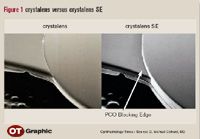Article
Accommodating IOL design modification reduces PCO
Author(s):
Los Angeles-Preliminary results from a prospective study of patients with the crystalens square edge (SE) accommodating IOL (eyeonics) implanted suggest modification of the original optic edge design has been effective for reducing the development of posterior capsule opacification (PCO) and without causing an increase in visual quality-related complaints, according to D. Michael Colvard, MD.

Dr. Colvard, assistant clinical professor of ophthalmology, University of Southern California, Los Angeles, undertook the prospective evaluation of the crystalens SE in collaboration with Paul S. Koch, MD, a private practitioner in Warwick, RI. Between October 2004 and March 2005, they implanted the new model of the accommodating IOL in 125 consecutive eyes of 81 patients.
Planned follow-up is to 3 years, but an interim analysis was performed based on 96 eyes seen at 1 year, and the results showed PCO development was consistently minimal to absent.

"The original crystalens was associated with a high incidence of opacification and a 30% rate of Nd:YAG laser capsulotomy after 1 year in the FDA study," said Dr. Colvard, who is also in private practice in Encino, CA. "So far, capsulotomy has not been needed at 1 year in our series of eyes with the modified edge IOL implanted. The objective analysis demonstrates there is virtually no capsular opacification of the entire optic and none whatsoever of the central 3-mm zone."
In the original crystalens, the optic had a tapered edge, and the lens edge adjacent to the plate haptic was flush to the haptic surface. The new crystalens SE platform features an optic with a continuous square edge. In addition, the haptics are inserted 0.1 mm anterior to the posterior edge. With that configuration, posterior pressure is exerted against the posterior capsule, thereby increasing the effectiveness of the mechanical barrier to lens epithelial cell migration beneath the lens.

All patients were eligible for inclusion in the prospective study unless capsular fibrosis was noted intraoperatively (two eyes). The patients enrolled were predominantly female (72%) and had a mean age of 69 years.
Newsletter
Don’t miss out—get Ophthalmology Times updates on the latest clinical advancements and expert interviews, straight to your inbox.





